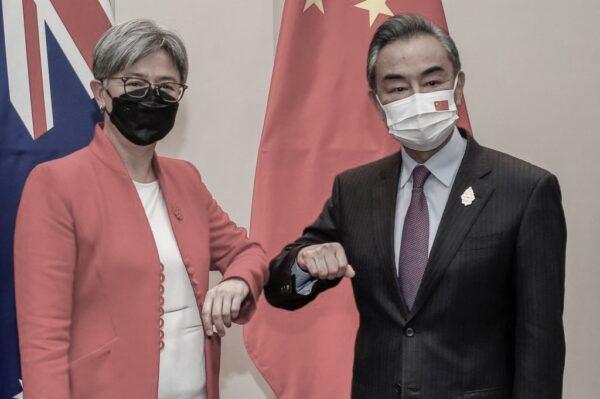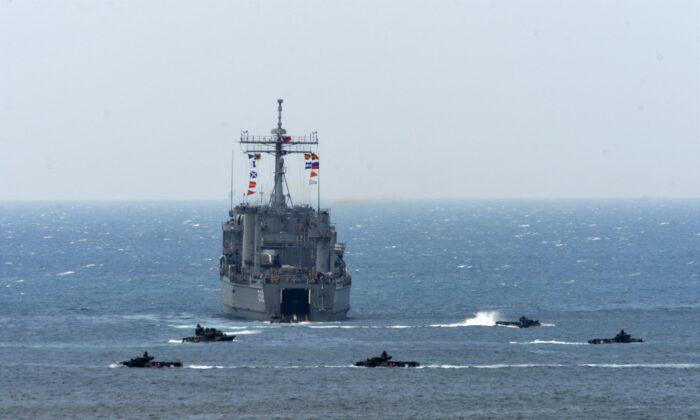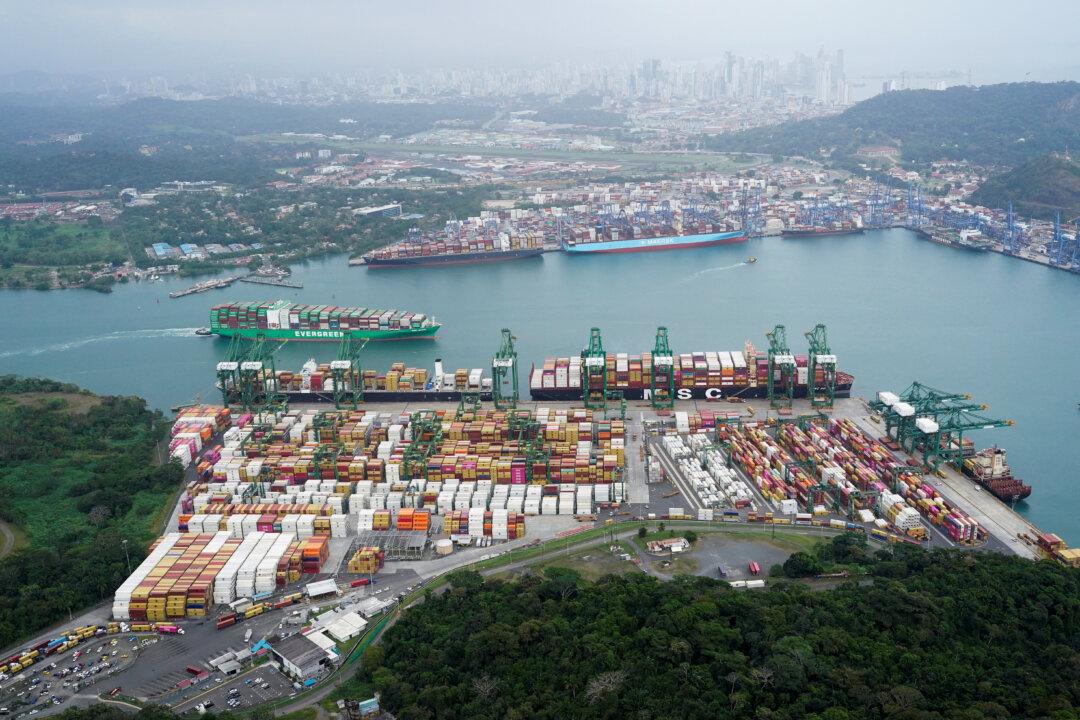China has intensified its strategic onslaught into the South Pacific since the start of the Russia-Ukraine war in February 2022.
Despite the theoretical strategic advantage of the AUKUS alliance of Australia, the United Kingdom, and the United States, momentum in the Indo-Pacific has begun to move in favor of Beijing and away from Washington and its allies.
It is a transformation that has not featured in the headlines of any Western media in recent months.
Part of the revived momentum of Beijing’s strategic activities reflects the domestic need of Chinese Communist Party (CCP) leader Xi Jinping to show virility and leadership in the run-up to the 20th CCP Congress later in 2022. That significant political event will be the crucial watershed for Xi’s career. But most of China’s stepped-up activity in the region is the opportunistic use of the cover of the Russia-Ukraine war to distract from its island-hopping strategy.
As well, the total economic and social meltdown in Sri Lanka—largely the result of the CCP’s predatory Belt and Road Initiative (BRI) debt diplomacy—serves as a major distraction for Sri Lanka’s neighbor, India, which has been attempting to hold the line against the southward thrust of China on India’s Tibetan border and in South and Southeast Asia.

For much of this, Beijing can thank the current U.S. administration of President Joe Biden for making the Russia-Ukraine war the apparent focus of U.S. strategic attention. Washington has maintained near “radio silence” on China, with some exceptions and diplomacy in the Indo-Pacific by U.S. Secretary of State Antony Blinken. But to all intents, Washington has not seriously pushed back against Beijing’s revived “wolf warrior diplomacy” and physical expansion into the region.
The main impediment to China’s expansion of influence and actual military capability in the South Pacific—and, indeed, the Indo-Pacific generally—has historically been the influence and capability of the United States. And while the U.S. Defense Department has been steadily focusing on China’s attempted break-out into the Pacific, the Biden administration has pointedly ignored the region. Even the May 24 meeting in Tokyo of the Quadrilateral Alliance (India, Japan, Australia, and the United States) saw Biden only calling for the Quad to back U.S. sanctions against Russia. Even this failed, with India refusing to join the U.S. position.
The creation of AUKUS in September 2021 seemed to serve as a significant warning to the CCP. Still, it was insufficient to halt Beijing from attempting to create a South Pacific-wide accord between China and the smaller independent states of the region. Chinese Foreign Minister Wang Yi’s protracted sweep through the states of the region in the wake of the signing of the China-Solomon Islands security compact—which Solomon Islands Prime Minister Manasseh Sogavare described as a treaty—in April 2022 has steadily been yielding results. And the most significant pushback against China has come less from the United States, Australia, and New Zealand but as much from the concern of South Pacific governments.
Recently, some states have happily played off Beijing against the Australian and New Zealand governments (as well as the United States), gaining maximum financial attention from all potential donors, investors, and lenders. But some of these states—particularly Fiji and Papua New Guinea—have shown signs of concern over the CCP’s aggressive attempts to position itself in the region. The CCP already has a significant position in controlling ports in many regional states, including Daru, in southeastern Papua New Guinea, the closest port to the Australian mainland.
Beijing has not only locked in control of harbors in the region, including in Australia itself, but it has also positioned “fishing fleets”—which neither fish nor move—in areas encroaching on the territorial waters of regional states such as the Philippines and Australia. A major Chinese “fishing fleet” appears to be moored just off Australia’s Norfolk Island chain, situated between the Australian mainland and northern New Zealand.

These are just some examples of China’s inexorable push into the Indo-Pacific by using various covers for its efforts. By 2022, Beijing’s geostrategic positioning began to strongly resemble Imperial Japan’s Greater Asia Co-Prosperity Sphere of the late 1930s and early 1940s. In many ways, too, it reflects the CCP’s strategic reach into the African Continent in the wake of the collapse of U.S. and Western influence there in the first decade of the 21st century. Beijing has been essentially pushing into vacuums created by decreased or poorly managed Western influence in Africa and the Indo-Pacific.
The momentum has been with China, given the fact that Australia, New Zealand, and the United States had seemed, for decades, to take their suzerainty of the South Pacific for granted.
On May 28, China signed another strategic deal in the region—this time with Samoa. A few days earlier, on May 24, Australia’s new Labor Party government of Prime Minister Anthony Albanese was sworn into office with the promise that it had a “comprehensive plan” ready to offer to the Pacific Islands. But despite immediate visits to the region by incoming Foreign Minister Penny Wong, little has emerged of that plan.
On July 8, writing in Spectator Australia, Australian maritime expert Stuart Ballantyne, after decades of experience working with Pacific Islands states, stated bluntly that the regional microstates were fed up with being given Australian aid that was not only useless, but expensive to maintain. He particularly referred to Australia’s gifts of expensive Guardian-class 39.5-meter patrol vessels.

“Does anyone in DFAT [Australia’s Department of Foreign Affairs and Trade] visit and ask these South Pacific nations what they need?”
Most South Pacific Islands people value the fact that they can freely visit Australia and New Zealand, where many of their relatives live, work, and are educated. But they sense new opportunities from Chinese investments and loans, and they relish the fact that now, finally, they are getting some attention from Washington, Canberra, and Wellington.
Regional power center Fiji, under the present Prime Minister Frank Bainimarama, a former navy commander, has been keen to promote better ties with China, given numerous occasions of confrontation with Australia (despite consistent Australian disaster relief and other support for Fiji). However, even the Fijian government has now become concerned at the CCP’s insinuation into every aspect of Fijian and South Pacific governance.
U.S. Vice President Kamala Harris was invited to make a video link address to the Pacific Islands Forum, held in Fiji’s capital Suva on July 12. It was an honor not accorded to China, and the United States made the most of it, offering to triple U.S. aid to the Pacific Islands from $20 million to $60 million a year for the next decade.
Significantly, China’s defense attaché and deputy defense attaché from the embassy in Suva had gatecrashed the presentation to the forum. When this was brought to the hosts’ attention, Fijian police escorted the two from the room.
The “new Battle for the Pacific” has been joined, and, as with World War II, the West has arrived late for it, remaining strategically distracted by the war between Russia and Ukraine. Indeed, Western support for Ukraine has drained the limited ammunition and other resources needed to build up the forces to contain China in the Indo-Pacific, exposing virtually all Western defense forces as unable to sustain long-term conflict with any adversary.
The new Australian government’s plans to build defenses against China have already been dealt an economic blow by commitments of spending—at a time of escalated inflation—scarce funds for social and green energy programs. And in the United States, the amount of funds, weapons, and ordnance already diverted to Ukraine from a defense budget depleted by inflation is equal to almost double Australia’s total defense spending.

Meanwhile, China has taken the smokescreen created by the Russia-Ukraine war to ramp up its conflict against Taiwan. China’s Taiwan Affairs Office spokesperson said on July 13 that there was “no such thing” as a center line in the Taiwan Strait because Taiwan and the mainland both belong to “one China.”
She said that China’s newly-launched Coast Guard vessel, the cruiser-sized warship Haixun 06 (6,600 tons, capable of patrolling for 60 days with a range of 10,000 nautical miles), was tasked with rescue, investigation, and surveillance operations for coastal waters off Fujian in the Taiwan Strait. Taiwan’s Mainland Affairs Council (MAC) responded that it would monitor closely what comes next.
The CCP’s People’s Liberation Army (PLA) and Ministry of Foreign Affairs seem to have moved to new rhetoric on the Taiwan issue. When U.S. Sen. Rick Scott (R-Fla.) visited Taiwan on July 8, both spokespersons of China’s foreign ministry and the PLA’s Eastern Theater Command stated that the “Taiwan issue is purely China’s domestic affair. Reunification [of Taiwan with the mainland] is absolutely to be realized.”
This followed the Chinese foreign ministry spokesperson’s pronouncement on June 13 that the Taiwan Strait is not international waters. It is now probable that the Chinese navy may be on alert to back up the operation of Haixun 06 in the Taiwan Strait. If that proved to be the case, it would be a new tool of coercion for the run-up of the Party Congress and afterward. Thus, the CCP seems to be ready for escalation.
So the big war has begun in the Indo-Pacific while the Biden White House acts as though the Russia-Ukraine war—in which the United States and NATO are not formally engaged—is the only show in town.





